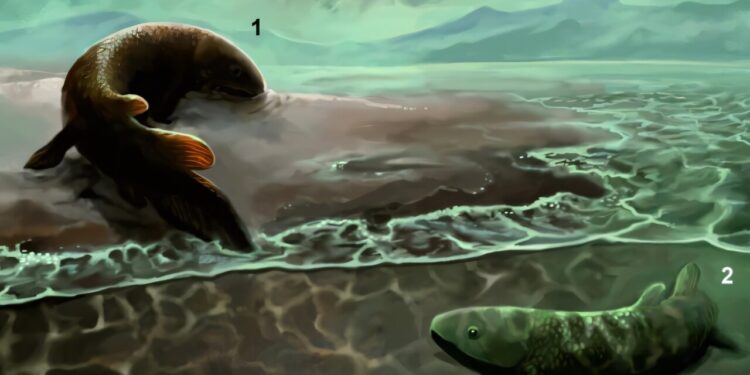Reconstruction of the way in which Acutori Igen reptanichnus. And ISP. Nov. 1) and Broomichnium ujazdenSis ISP. Nov. 2) were created. Credit: Jakub Zalewski. Scientific relationships (2025). DOI: 10.1038 / S41598-025-14541-8
The Polish National-National Research Institute reports a fossilized fossilized path of the lower Devonian (419 to 393 million years) in the mountains of the Holy Croix, in Poland, attributed to Dipnoan fish. Their analysis finds what seems to be the first recording of fish testing the earthly mobility skills of the vertebrates, prior to around 10 million years the first proof of a fully earthly locomotion of the tetrapods.
Prestimation to invasion on earth is a requirement for more permanent stays, probably motivated by access to new food areas during low tide. Few sites have recorded traces of locomotion of the first vertebrates to colonize the land, mainly from Europe and one in Australia, the oldest to date coming from the lower de Deonian of the mountains of the Holy Cross, in Poland.
Many terrestrial locomotoire traces of a similar age occur on the island of Valentia, Ireland. The evidence indicates that tetrapods were already capable of an effective locomotion on land at the start of the average Devonian, which suggests that the origins of quadrupedalism should be sought in even older formations.
In the study, “the traces of Dipnoan fish document the first adaptations of vertebrates to move to earth”, published in Scientific relationshipsThe researchers analyzed the fossils newly excavated traces and 3D analyzes to interpret the locomotion and the anchoring of the muzzle attributed to the Dipnoa fish.
The field teams worked two sections in small abandoned sandstone quarries in Ujazd and Kopiec near Iwaniska in the mountains of the Center of the Holy Cross, about 190 km south of Warsaw, in the Marginal Siliciclastic Marginal Deposits (Intermediate Emsian). Here, the sandstones have been trained in a marginal marine environment showing many manifestations of emersion and colony by terrestrial vegetation.
Location of outcrops studied in Ujazd and Kopiec. A) Location map in the geological sketch of the Holy Cross mountains (HCM), Central Poland. B) Section studied in Ujazd with marked fossil horizons. C) a photograph of the part of the caroring horizon. D) Comparison of the 3D reconstruction of the muzzle with traces of fossil in the lateral view4. Credit: Scientific relationships (2025). DOI: 10.1038 / S41598-025-14541-8
The coverage of Tuffite protected the traces of bioturbation, producing “True substrate” litter plans which record the sedimentary-water or sediment-air interface and a period of stasis before subsequent deposit. An area of around 30 m2 in Ujazd and about 15 m2 In Kopiec preserves several dozen documented traces in situ.
The methods included the excavation of partially exposed sandstone bed surfaces, cleaning and washing, land photography, 3D sweep, silicone rubber flow and in situ protection. The measures and analyzes used a 3D Evixscan aupe + scanner and were analyzed with Blender 2.6. The 3D scanners were also carried out using a Zscannttm 800 h hand scanner with an XYZ 50 mm resolution.
The characteristics of the snout imprints include a trapezoidal outline in dorsal view, a deep curved profile of the lower jaw in lateral view and a pair of arches in the ventral margin of the upper lip which correspond to the short-free dedicated dedicated pulmonary fish such as Dipnorhynchus or “Chirodipterus”.
Interpretation excludes swimming because the sinusoidal model characteristic of antichna is absent. Observations document nearly 11% of twisted traces, 97% of which are twisted on the left. A set of merged data of 35 traces of filming on the left seems to be statistically significant and can represent the first alleged example of restraint among vertebrates, with a possible left -handed preference.
The researchers conclude that one of the tracks was produced by a partially emerged dipnoan fish, including the traces of the trunk, the fins and the anchoring of the muzzle in the sediments for the body leverage, with fins used as auxiliary tools to adjust the movement. In another, simple or double pairs of furrows record a fish based on its fins in the sediments.
The evidence represents the oldest locomotion of the vertebrates known in a semi-terrestrial environment and reveal anatomically shared or convergent capacities of a sister group regardless of the real tetrapod line.
Written for you by our author Justin Jackson, edited by Sadie Harley, and verified and revised by Robert Egan – This article is the result of meticulous human work. We are counting on readers like you to keep independent scientific journalism alive. If this report matters to you, please consider a donation (especially monthly). You will get a without advertising count as a thank you.
More information:
P. Szrek et al, Traces of Dipnoan Fish document the first adaptations of vertebrates to move to Earth, Scientific relationships (2025). DOI: 10.1038 / S41598-025-14541-8
© 2025 Science X Network
Quote: The fish tracks show the first adaptations to move to earth (2025, August 19) recovered on August 20, 2025 from
This document is subject to copyright. In addition to any fair program for private or research purposes, no part can be reproduced without written authorization. The content is provided only for information purposes.



